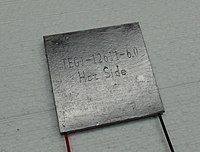
Photo from wikipedia
Abstract This paper examines the effects of varying the battery pack geometry, mainly the spacing between the batteries in the pack, when it is cooled with recently proposed liquid to… Click to show full abstract
Abstract This paper examines the effects of varying the battery pack geometry, mainly the spacing between the batteries in the pack, when it is cooled with recently proposed liquid to vapor battery cooling systems. In these, the coolant forms a liquid pool in which the batteries in the pack are partly or completely submerged. The liquid pool is kept at a pressure for which the corresponding saturation temperature is around the lower end of the battery optimum operation temperature. When the batteries are charging or discharging they generate thermal energy and their temperature increases, and exceeds the saturation temperature of the pool. Then, the pool absorbs the generated heat and starts to evaporate. Some of the advantages of the liquid to vapor cooling system are higher latent heat, which increases the amount of heat the system can remove, and constant phase change temperature. In addition, the phase changing from liquid to vapor has the advantage of high heat transfer rate of boiling when the temperature of the surface is high enough (5 °C more than the saturation temperature). The main parameter considered in this study is the spacing between the batteries in the pack. Four different battery spacings are considered, which are essentially multiples of the radius of the battery, including twice the radius, equal to the radius and half of the radius. The effects on the performance of the considered parameters are measured and assessed through the thermal performance of the cooling system, which is measured by the battery maximum temperature and the maximum temperature difference across the pack and through the battery. The performance is assessed through 600 s of charging and discharging cycles for various cycle rates (4C, 5C and 6C) and for a constant amount of liquid coolant initially covering the entire height of the battery. The results show that reducing the spacing between the batteries increases the maximum temperature of the battery, but improves the thermal uniformity through the battery. Only the configuration with battery spacing equal to twice the radius, was able to maintain coolant in the liquid phase at the end of the 600 s 4C cycle.
Journal Title: Energy Conversion and Management
Year Published: 2019
Link to full text (if available)
Share on Social Media: Sign Up to like & get
recommendations!